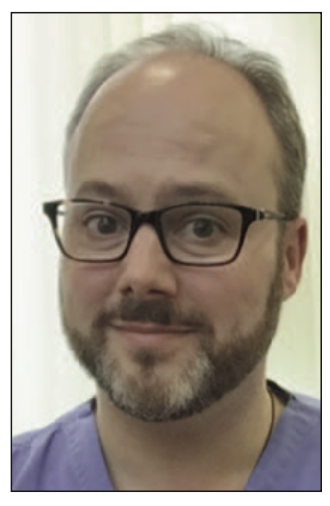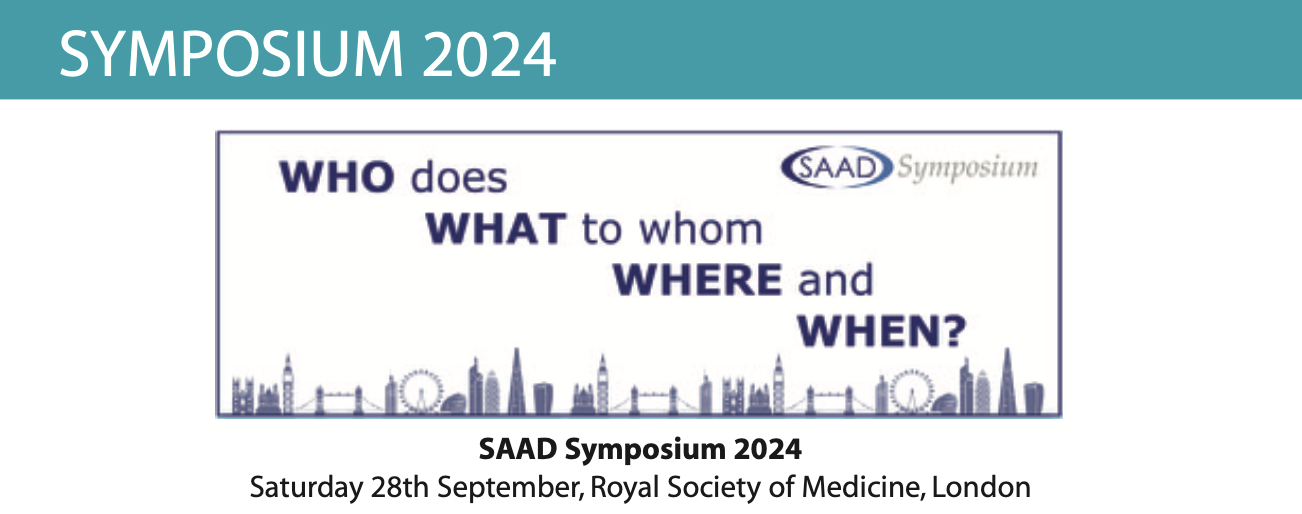
The 2024 SAAD Symposium once again returned to the Royal Society of Medicine and proved to be an exciting and thought-provoking programme showcasing enthusiastic, passionate and dynamic clinicians from the world of dental sedation and beyond. SAAD’s President, Sadie Hughes, welcomed delegates to the day and expressed her thanks to Christopher Holden and Imran Suida for curating the programme and speakers.
Nadiya Suida and Elisha Mistry delivered the first presentation of the day and provided a wonderful insight into adolescent intravenous sedation (IVS) from their perspective in Bradford’s Community Dental Service. They provided a pragmatic and real-life view of managing this age group, sharing hints and tips to aid with patient assessment and selection, securing venous access and delivering calm and effective dental treatment. Their experience demonstrates that IVS offers a safe, effective and efficient alternative to general anaesthesia (GA) for patients aged 12-16, both reducing treatment waiting times and easing pressure on GA services. They closed by encouraging the audience to be brave and consider the more widespread use of IVS for this age group.
The second lecture of the session was from Sarah Higham who brought a refreshing international perspective, depicting her experiences with providing peripatetic sedation services in Australia. Sarah discussed her approach using multi-drug sedation and the governance and compliance requirements in Australia. Whilst the specific techniques described may not be commonly employed in the UK, Sarah’s real-life case studies beautifully illustrated that delivering a careful blend of sedative agents can match the level of sedation to patient need, whilst remaining safe and predictable. Although much of the audience may not plan to provide this form of sedation in the UK, Sarah’s approach to audit, peer review and self-reflection was creditable and will undoubtedly inspire practitioners to reflect on their own clinical practice.
The first presentation after the morning break was by Joanna Dick from Guy’s Hospital. Joanna discussed the spectrum of pre- medication which can be employed to aid anxious patients to manage the challenging experience of cannulation. Options including premedication at home, oral sedation, intranasal midazolam and inhalation sedation were explored and the pros and cons presented. Joanna shared practical and helpful tips to guide practitioners through the clinical decision-making process and to provide solutions to improve patient comfort and procedural success.
The final presentation of the morning was from Munir Ravalia who impressed attendees with a captivating session on hypno-sedation. Munir discussed the importance of psychosocial factors in dental anxiety and the need for clinical teams to identify and manage this area to deliver effective care. Munir’s practical demonstration of clinical hypnosis was fascinating and provided an insight into how such therapies can help patients manage their fears and access care. The potential benefits and synergies of blending clinical hypnosis and conscious sedation techniques was a clear take away message from this session.
The afternoon session was opened by the newly elected SAAD President, Yi Kwan Loo. Yi thanked Sadie Hughes for her time as President and expressed her excitement and enthusiasm to be taking on her new role for SAAD.
The first presentation of the afternoon was delivered by anaesthetist and HEMS doctor, James Nayyar. James’ relaxed and self-effacing style created an enjoyable and engaging presentation exploring the challenges of delivering immediate care and sedation in the pre-hospital emergency environment. The vibrant case studies demonstrated how lessons learnt from intense and high-pressure situations could be extrapolated into primary dental care encouraging clinical teams to be flexible and adaptable, but also use a clear framework such as clinical checklists to ensure consistency and predictability.
David Johnson provided a wonderful overview of acupuncture and its role in modern clinical dentistry. David explored the complimentary indications of acupuncture in the management of dental anxiety and other indications such as the management of Temporomandibular Disorder (TMD) symptoms and gag reflex. David’s witty and illuminating delivery kept the delegates engaged and undoubtedly will have inspired many to explore and investigate this interesting topic further. Clearly, acupuncture is an exciting and non-invasive technique which can facilitate and complement a patient-centred approach, ultimately enhancing patient comfort and treatment outcomes.
In the final presentation of the day, Paul Howlett shared details of SAAD’s new Safe Sedation Certificate (SSC). This new, remote scheme sits alongside the well-established SAAD Safe Practice Scheme (SSPS) and seeks to provide a streamlined, cost-effective and robust peer evaluation process for sedation services. External validation and peer review is a fundamental principle of the IACSD Standards and SSC provides a novel and user-friendly way for sedation settings to meet this requirement and achieve quality assurance thereby enhancing patient care, safety and treatment outcomes.
The 2024 SAAD Symposium was closed by SAAD President, Yi Kwan Loo, thanking delegates for their attendance and the speakers for sharing their experience, knowledge and insights.
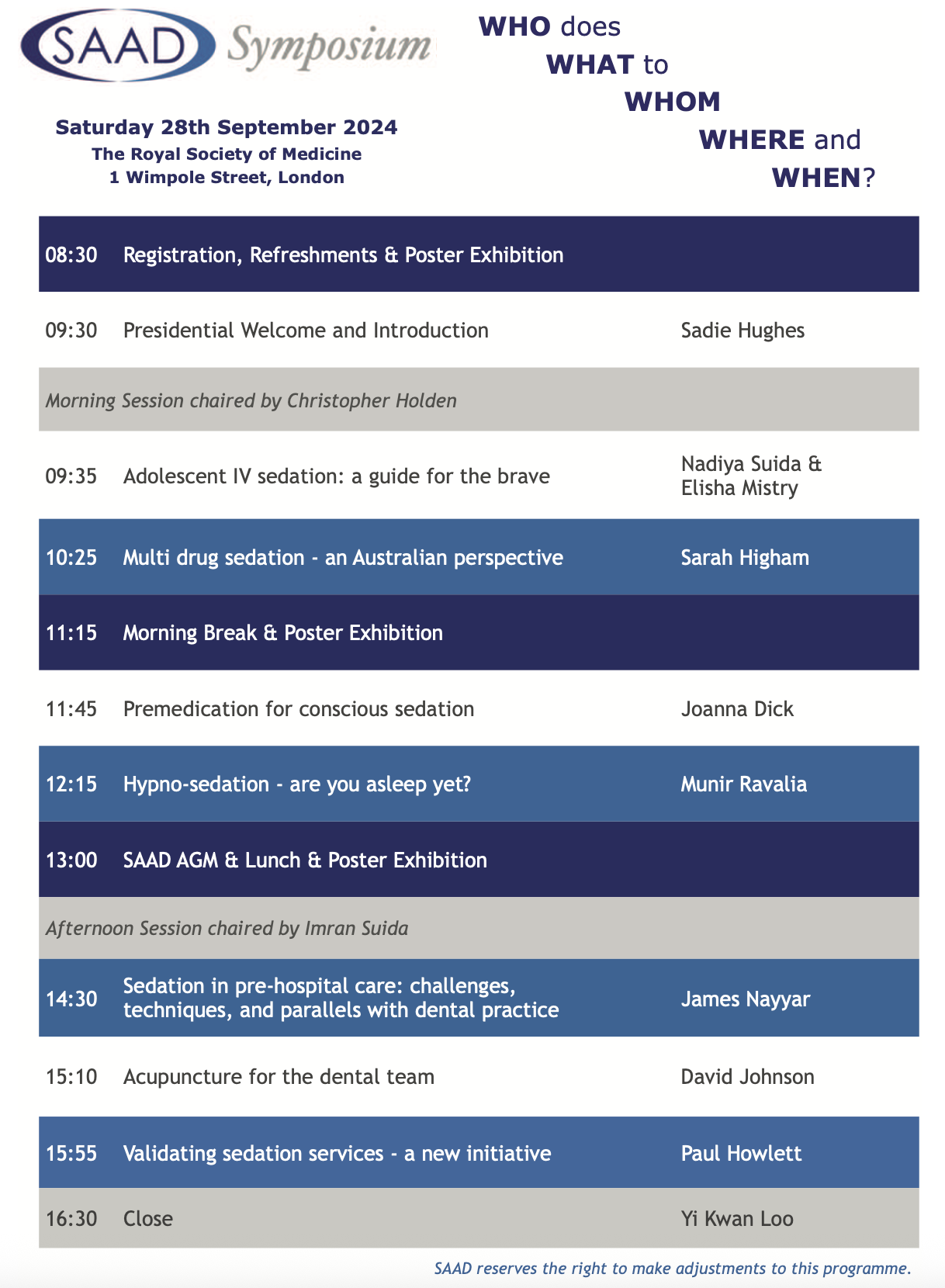
SAAD annual symposium speaker abstracts
Adolescent IV sedation
Nadiya Suida BDS (Ncle) MFDS (RCS Glas) Dip Con Sed (Ncle) PG Cert Healthcare Leadership (Brad)
Clinical Director and Conscious Sedation Lead, Bradford District Care NHS Foundation Trust Community Dental Service
Elisha Mistry NEBDN National Diploma in Dental Nursing, NEBDN Certificate in Dental Radiography, and NEBDN Certificate in Dental Sedation.
Senior Dental Nurse in General Anaesthesia, Bradford District Care NHS Foundation Trust.
Correspondence to: nadiya.suida@bdct.nhs.uk and elisha.mistry@bdct.nhs.uk
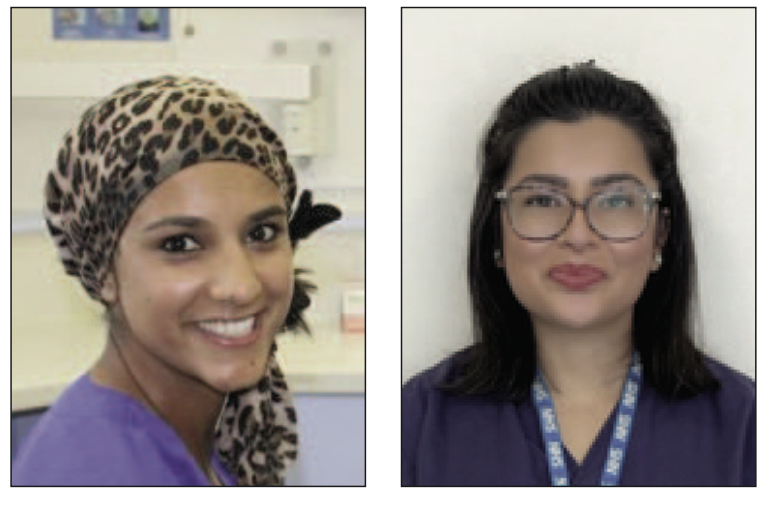
It is well known that dental anxiety can form major barriers to care, especially for children. Nitrous oxide inhalation sedation is a popular choice for paediatric patients, though may not always be successful for highly anxious or phobic young people, or those requiring complex treatment. Children who are unable to co-operate with local anaesthetic alone or in combination with inhalation sedation, often have to face general anaesthetic as a last resort for completion of treatment. Providing intravenous sedation (IVS) to 12–16-year-olds with midazolam, is a viable option in this patient group and though it can be challenging, it can also be incredibly successful and rewarding.
Though national conscious sedation guidance dentistry states that IVS with midazolam is a ‘standard technique’ for patients over 12 years, there is sometimes reticence around provision for this age group, due to the increased risk of paradoxical reaction and poor co-operation. Being mindful of key aspects of sedation assessment, however, can really help to optimise success and the chance of a successful outcome. Considering differences in anatomy, baseline vital signs, respiratory physiology and drug metabolism, alongside providing a holistic approach to the whole episode of care, are all key.
The paediatric cohort rely much more heavily on continued reassurance and behavioural management throughout IVS, compared to their adult counterparts. There are also a number of elements of the practical delivery of IVS, which can differ compared to provision in adult patients. These often relate to titration, response, reactions to oral stimuli and the optimum sedation window.
Supporting these patients through their sedation episode appropriately at each stage, is vital to success.
Recent local audits provide good assurance around the safety of the technique and successful clinical outcomes as well as highlighting very good patient reported outcomes and patient experience.
It is quite common for children to be dental phobic. Although nitrous oxide inhalation sedation can be a solution to aid treatment for this cohort of patients it is not always successful for those that are extremely anxious or require complex treatment. When inhalation sedation fails, often the next viable option to aid treatment is carried out under General Anaesthesia (GA) as a last resort. In 2019 Bradford Community Dental Service (CDS) introduced a paediatric intravenous sedation pathway for 12–16- year-olds using midazolam. This option decreased waiting times for patients undergoing treatment and helped to reduce pressure on GA waiting lists caused by the COVID-19 pandemic.
Treatment under IVS for paediatric patients can be challenging, but it can also be very rewarding and reduce risk to the patient in comparison to treatment under GA. As a dental nurse, behaviour management is key when supporting this patient group undergo treatment with IVS due to the increased risk of paradoxical reaction and poor cooperation. This cohort of patients often display unpredictable behaviours, and it is important for the dental nurse to remain vigilant while monitoring the patient and providing constant reassurance to the patient is vital to success.
In comparison to their adult counterparts, the delivery of IVS can differ for the paediatric patient group. The optimum sedation window for the paediatric cohort is often very short resulting in a much faster recovery rate compared to adults. Other aspects that differ include the response to midazolam, reactions to oral stimuli and appropriate titration.
Multi drug sedation - an Australian perspective
Sarah Higham BDS UMDS 1993 Dip D Sed Guy’s 1998
Mobile sedation practitioner in Queensland, Australia.
Correspondence to: scsedation@gmail.com
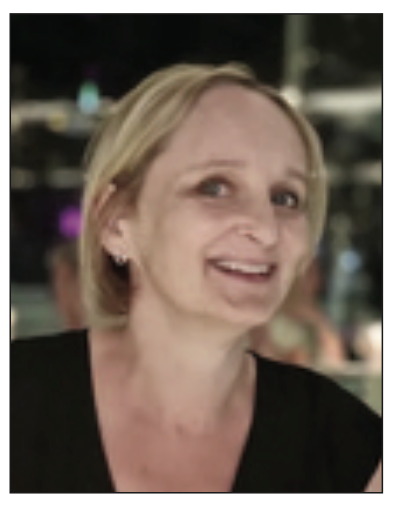
Current dental sedation practice in the UK is mainly single drug sedation and there are multiple training pathways available. In Australia a two-year, part-time diploma at Sydney University is the only place which offers training to become a Dental Sedationist. After graduating you will be competent in polypharmacy sedation.
Sarah Higham talked about her journey, single drug sedation in the UK through to her current practice of polypharmacy.
Sarah outlined the training pathway, registration requirements and ongoing professional obligations for the Australian sedationist.
She outlined the way in which combinations of multiple drugs and in some circumstances fewer drugs can be used to achieve satisfactory results. Sharing patient case studies to illustrate both successful outcomes and some that were memorable for the wrong reasons. In doing so, she hopes that the listener gained an understanding of how multidrug sedation can be delivered in a safe and effective way.
Premedication for conscious sedation
Joanna Dick BDS, MJDF (RCSEng), PG Dip Cons Sed, MSc (SCD), MSCD, PGCert (ClinEd)
Consultant in Sedation and Special Care Dentistry
Correspondence to: joanna.dick@nhs.net
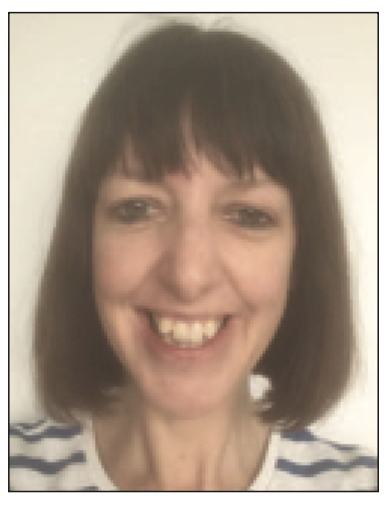
Cannulation prior to administration of intravenous sedation can be challenging; this may be due to needle phobia, severe anxiety, a movement disorder or a learning disability.
Different methods of premedication to aid cannulation were discussed such as a premedication at home, oral sedation, intra-nasal sedation and inhalation sedation.
Commonly given premedications include diazepam and temazepam. Although these are included in the dentists’ formulary, studies have shown that dentists are often hesitant to prescribe them. Often patients are prescribed premedications by their GP, who if appropriate can also prescribe alternative premedications such as lorazepam.
An alternative option is that patients are given oral sedation in the dental surgery; oral midazolam is usually the drug of choice, but temazepam can also be given. This has the advantage that is can be disguised in a drink but is subject to first pass metabolism, sometimes making its onset of action unpredictable.
Intranasal sedation with midazolam tends to be better absorbed and so have a much more predictable onset of action. It, however, can sometimes be poorly tolerated due to the stinging sensation on administration.
Inhalation sedation is a less commonly used method to achieve cannulation but can be effective in co-operative patients. It also has the additional benefit of vasodilation which can further aid cannulation.
As well as discussing some cases demonstrating these techniques, some tips and tricks of the trade were given.
Hypno-sedation - are you asleep yet?
Munir Ravalia BDS MFDS RCS Eng
Pain Management and Sedation, Lecturer Conscious Sedation, Department of Special Care and Sedation, Royal London Hospital
Correspondence to: munirrav@yahoo.co.uk
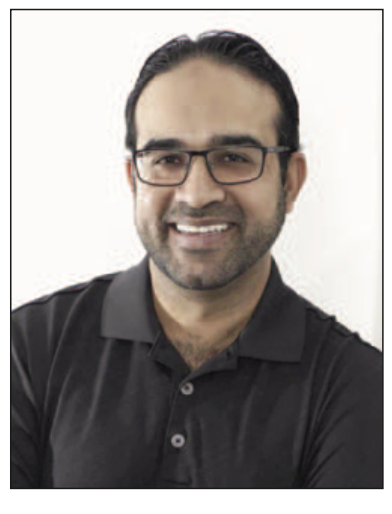
Identifying psychological factors involved in patients with extreme phobia and anxiety, and psychotherapeutic techniques can assist patients in their dental care.
Dental phobia and anxiety is a well-documented barrier to patients seeking dental care. The fear around the clinical dental environment such as sounds, needles, gagging etc means many patients only seek dental care when they are in extreme acute pain, and often need help with conscious sedation techniques or general anaesthesia.
There is variation in the extent to which differing behavioural management / support techniques are employed to facilitate care and options available to patients, with some specialist units having a dedicated psychology team to help these patients, who are often experiencing real life events and trauma.
Successful psychotherapeutic techniques such as clinical hypnotherapy are being used more and more often outside of the actual dental environment to help this cohort of patients overcome their phobia and fears.
Clearly identifying patients who may benefit from such therapy, can be life changing. Often this group of patients may have unsuccessful or 'failed' sedation and need such therapy to even them allow them to have conscious sedation successfully with a combined hypnosedation technique.
Sedation in pre-hospital care: challenges, techniques and parallels with dental practice
James Nayyar FRCA DipIMC (RCS.Ed)
Immediate Care Physician, East Midlands Immediate Care Scheme
Correspondence to: james.nayyar@emics.org.uk
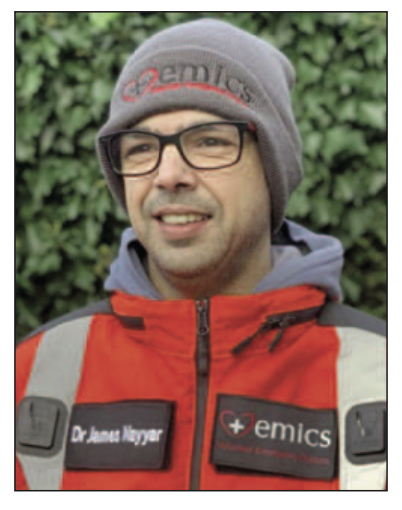
Sedation is a critical tool across many medical disciplines, including anaesthesia, pre-hospital emergency care and dental practice. However, the environments in which sedation is administered can differ significantly, offering unique challenges and insights. This presentation visited the world of pre-hospital care, where sedation plays a vital role in managing critically ill or injured patients in dynamic and often challenging situations.
With the backdrop of emergency medicine, how sedation is applied in the field was explored, the specific techniques and drugs used, and how these practices differ from those in the more controlled environment of a dental clinic. Through vivid real-life case studies drawn from experience as a HEMS (Helicopter Emergency Medical Service) doctor with The Air Ambulance Service, this presentation provided a taste of the art and science of sedation in the most challenging circumstances.
By understanding the rigors of pre-hospital sedation, dental professionals and others will gain a new perspective on their own practices and perhaps discover surprising parallels that can boost their own confidence in managing difficult or unexpected situations. This session was designed to be both informative and engaging, offering a glimpse into the world of emergency medicine and the valuable lessons it holds for all professionals, regardless of their field.
Acupuncture for the dental team
David Johnson, BSc (Hons), BDS (Wales), MFDS RCS (Eng)
Community Dental Officer, Cwm Taf Morgannwg uHB
Correspondence to: davethedentist@gmail.com
Acupuncture, a practice deeply rooted in ancient Chinese medicine spanning 3-4,000 years, emerges as a valuable adjunct for today’s dental practitioners. In the realm of dentistry, where patient comfort and treatment efficacy hold utmost significance, acupuncture offers a complementary avenue to manage a spectrum of conditions including TMJ pain, trigeminal neuralgia, and heightened gag reflexes.
Historically revered for its dual capacity to alleviate symptoms and bolster the body’s healing mechanisms, acupuncture introduces an additional therapeutic layer to conventional dental treatments. By targeting specific points on the body to stimulate physiological responses, dental professionals can potentially optimise pain management protocols and diminish reliance on conventional pharmacological approaches.
The contemporary relevance of acupuncture within dental practice stems from its holistic approach to patient care, addressing not only physical symptoms but also the emotional stressors that can impact oral health. This holistic perspective enables dental teams to broaden their treatment repertoire, tailoring therapies to meet the unique needs of each patient and fostering a more personalized approach to oral healthcare.
Acupuncture’s efficacy in managing TMJ disorders, for instance, underscores its role in mitigating chronic jaw pain often resistant to traditional interventions. By integrating acupuncture into treatment plans, dental providers can offer patients a comprehensive pain relief strategy that complements existing therapies, potentially reducing the need for higher doses of pain medications or invasive procedures.
Moreover, for individuals plagued by an exaggerated gag reflex during dental procedures, acupuncture presents a non-invasive technique to desensitize hypersensitive oral tissues. By stimulating specific points associated with relaxation and neuromodulation, dental professionals can help patients undergo necessary treatments more comfortably, minimizing procedural challenges and enhancing overall patient satisfaction.
In conclusion, acupuncture enriches modern dental practice by offering a multifaceted approach to patient care. Its integration complements traditional therapies, extends treatment options, and supports a patient-centered approach that acknowledges the interconnectedness of physical and emotional well-being. By embracing acupuncture, dental teams elevate their capacity to deliver comprehensive, personalised care that optimises patient comfort, treatment outcomes, and oral health wellness.
Validating sedation services
Paul Howlett BDS MFDS DipConSed
General Dental Practitioner, Queensway Dental, Billingham.
Correspondence to: paul.howlett@queensway.co.uk
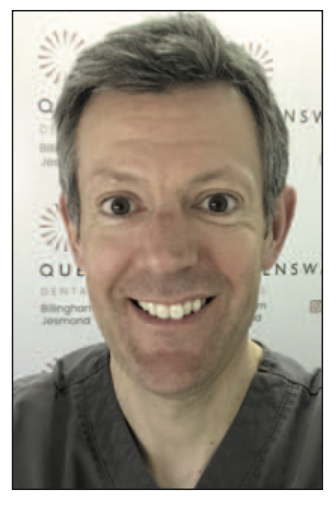
The IACSD standards are clear that all centres providing conscious sedation for dentistry should be inspected to ensure the necessary standards are in place and to promote high quality clinical care and patient safety.
SAAD has offered the Safe Practice Scheme (SSPS) for many years which provides a robust and thorough evaluation of sedation settings for providers. This scheme involves review of practice documentation, governance and protocols and observation of ‘live’ sedation cases demonstrating the sedation techniques being delivered. This process is an excellent way to quality assure services and to offer peer review for clinicians and providers to improve and update their practice and patient care.
The challenge with SSPS in its current form is the time and cost associated with evaluators needing to attend settings in person and for some clinics being able to schedule sufficient cases on one day for observation. This can present a barrier to the timely completion of the programme and may lead to many providers opting not to undertake the scheme.
Recently SAAD has developed an alternative approach to sedation services evaluation with the new SAAD Safe Sedation Certificate (SSC). This combines review of practice documentation and protocols with online meetings with the sedation team and evaluator to offer peer review, feedback and guidance. This makes the process more streamlined, accessible and cost effective whilst still providing external validation and quality assurance.
This talk shared the key aspects of the new SSC programme and provided an overview of the process and benefits of this exciting new scheme.
SAAD annual symposium poster presentation abstracts
1st Prize
Sustainability in Dental Sedation: Mitigation of Nitrous Oxide Emissions in a Private Paediatric Dental Clinic
Reena Amin, BDS, MJDF RCS, MSc Paediatric Dentistry, Dentist,
Happy Kids Dental Marylebone, 74–78 Seymour Place, London, W1H 2EH.
Amrita Singh, BDS, MClinDent Paediatric Dentistry, Dentist with
Special Interest in Paediatric Dentistry, Happy Kids Dental Marylebone, 74–78 Seymour Place, London, W1H 2EH.
Prabhleen Anand, BDS, IQE, MMedSc (Oral surg), FDSRCS(Eng), MPaedDent, FDS(Paed Dent), Cert. Pain and Sedation.
Consultant in Paediatric Dentistry
Royal National ENT and Eastman Dental Hospital, University College London Hospital NHS Trust, 47-49 Huntley Street, London, WC1E 6DG
Correspondence to: Reena Amin
Email: reenaamin01@hotmail.com
Background
Inhalation sedation using nitrous oxide / oxygen (N2O / O2) is a pharmacological technique used to provide dental treatment in anxious children. However, N2O is a greenhouse gas, which contributes to climate change. SDCEP have published guidelines on reducing emissions from dental sedation provision without compromising patient care.
Aim
To review clinical administration of N2O according to the SDCEP guidance, at a primary care private practice and effect change to improve practice.
Design
Data was collected retrospectively for all sedation cases over a one-week period (cycle 1). This included the volume of N2O, justification and success for each sedation case. All members of the dental team were informed of sustainability issues surrounding N2O and the results of the evaluation were disseminated to all members of staff. Recommendations for change were made and data collection was repeated (cycle 2).
Results
After disseminating the findings and implementation of changes indicated by the evaluation, the second cycle indicated a reduction in the clinically administered volume of N2O by 28% over a one- week period. Appropriateness of the cases was 100% in both cycles and there was 0% failure results.
Conclusions
The volume of N2O clinically administered over one week was reduced after local recommendations thus reducing the N2O emissions in a private practice.
2nd Prize
Getting it Right for the Autistic Patient: Maximising Clinical Outcomes under Conscious Sedation
Jalpa Patel*1 Sukina Moosajee2, Julie Edwards2
1Specialty Registrar Special Care Dentistry, King’s College Hospital NHS Foundation Trust
2Consultant in Special Care Dentistry, King’s College Hospital NHS Foundation Trust
Correspondence to: Jalpa Patel
Email: Jalpa.patel6@nhs.net
Background
Autism spectrum disorder (ASD) is a lifelong neurological condition characterised by challenges in social skills, repetitive behaviours, communication and sensory differences. Classification is according to the level of support an individual requires. Receiving dental treatment can be challenging for a patient with ASD therefore conscious sedation is often used avoiding the need for general anaesthesia.
Aim
A review of cases of conscious sedation in patients with ASD treated within special care dentistry at King’s College Hospital from January 2024 to July 2024 was carried out to assess if the proposed treatment had been completed successfully.
Method
Sixty cases of conscious sedation were recorded across 43 patients with 90% under intravenous sedation and the remaining with inhalation sedation.
Results
The largest group treated were in the 16-19 age group (n = 14). 13% (n = 8) of treatment episodes were unsuccessful, reasons given were failed cannulation and a short sedation window. 26% of cases recorded poor operating conditions with this most common in the ASD 1 level patients (n = 9). Reasons given for this score were related to sensory differences and disinhibition.
Conclusion
Therefore for the majority of patients with ASD despite difficult outcomes clinicians are able to achieve the desired treatment avoiding the risks associated with general anaesthesia.
Virtual Reality as an adjunct to Dental Sedation: Friend or Foe?
Chloe Bass, BDS, BSc, MJDF RCS (Eng), MFDS RCS (Ed)
Senior Dental Officer Oral Surgery at Central London Community Healthcare NHS Trust & Whittington Health NHS Trust
Correspondence to: Chloe Bass
Email: C.bass@nhs.net
Background
Virtual reality (VR) is an emerging technology which is growing in popularity in dentistry as a non-pharmacological technique to promote anxiolysis and analgesia.
Aim
VR allows the patient to immerse themselves in a human- computer interface to interact with the virtual world through a VR headset. VR offers a higher level of immersion than traditional distraction techniques and the effectiveness of VR in reducing dental anxiety and pain perception in children is well documented. Studies have demonstrated the benefits of VR during venepuncture for children, with a reduction in acute procedural pain and anxiety by modulating pain pathways.
Results
Patient feedback suggests an enhanced dental experience by creating an immersive environment that offers distraction from dental treatment. VR may subsequently reduce the titrated dose or eliminate the requirement for sedation altogether.
Conclusion
With any technology there are challenges that must be addressed e.g. cost, availability, quality of VR devices and software. VR headsets may hinder application in children receiving treatment under inhalation sedation who wear a nasal hood and the headset may mask early recognition of oversedation. Advances in technology are continually improving the usability and affordability of headsets and further research is required to realise the full potential of VR in dental sedation.
Efficacy and cost analysis of intravenous conscious sedation for long oral surgery procedures
Haidar Hassan DDS, MSc, PhD, FDSRCS*1
Rawand Shado2
Ines Novo Pereira LMD, MSc3
Manisha Mistry BDS4
David Craig MBE, FDSRCS5
1Clinical Senior Lecturer, Academic Plastic Surgery/Oral Surgery, Barts and The London School of Medicine and Dentistry, Queen Mary University, Centre for Cutaneous Research, Blizard Institute of Cell and Molecular Science
2Undergraduate student QMUL Institute of Dentistry
3PhD resident at University of Porto, Faculty of Dental Medicine
4Specialty Dentist, Department of Sedation and Special Care Dentistry at Guy’s and St Thomas NHS Trust
5Consultant in Special Care Dentistry, Chair, GSTT Conscious Sedation Committee, Guy’s and St Thomas’ NHS Foundation Trust, Honorary Professor of Conscious Sedation, University of Portsmouth
Correspondence to: Haidar Hassan
Email: h.hassan@qmul.ac.uk
Background
Long dental and oral surgery procedures are common indications for conscious sedation in dentistry. However, the current literature lacks clear definitions of what constitutes a ‘long’ versus ‘short’ oral surgery treatment. Defining these durations is important for interpreting research outcomes and optimising clinical protocols.
Aims
This study aims to define what is considered a long oral surgery procedure, particularly for extractions and implant fixture placement, determine the ideal intravenous sedation (IVS) protocol for these procedures and conduct a cost analysis of potential sedative agents.
Methods
A systematic review of human studies employing IVS for extractions and implant-related surgeries was conducted using PubMed and Google Scholar, covering studies from January 2003 to July 2023. Outcomes included sedative satisfaction, operator satisfaction and sedation assessments. Cost estimation was based on the British National Formulary (BNF) and the Cochrane Risk of Bias tools were applied to assess study quality.
Results
The average duration for extraction procedures under sedation was 31.33 minutes, with an upper limit of 46.80 minutes. For implant-related surgeries, the average duration was 79.37 minutes, with an upper limit of 149.09 minutes. Four intravenous sedative agents were analysed: midazolam, dexmedetomidine, propofol, and remimazolam. Midazolam was the most cost-effective, at less than 10 pence per patient per procedure. Propofol was the most expensive, at approximately £46.39 per patient. Remimazolam and dexmedetomidine were closely priced at £4.92 and £7.90, respectively, with remimazolam being the more economical. Infusion-based administration was consistently more expensive than injection-based methods.
Of the 29 randomised controlled trials (RCTs), 16 (55%) demonstrated a low risk of bias, as did 3 of the 6 cohort studies (50%), with other studies showing varying degrees of bias.
Conclusion
Midazolam, dexmedetomidine, propofol and remimazolam are safe and effective sedatives for conscious IV sedation in long dental procedures such as extractions and implant surgeries. While midazolam is the most cost-effective option, dexmedetomidine and remimazolam also offer competitive pricing. Further randomised clinical trials are needed to compare the efficacy of dexmedetomidine and remimazolam in clinical practice.
Audit of inhalation sedation outcomes for children and adult patients within the special care dental services
Dr Gopi Patel BDS*1
Dr Amar Kaul2
Dr Brasanyaa Raveendran (BDS)3
Dr Rob Emanuel4
1Joint Foundation Core Trainee
2Specialist in Special Care Dentistry
3Speciality Trainee 1 in Special Care Dentistry
4Consultant in Special Care Dentistry
Haywards Heath Health Clinic, Haywards Heath, West Sussex, RH16 3BB
Correspondence to: Dr Gopi Patel
Email: gopi.patel2@nhs.net
Introduction
The aim was to review the use of inhalation sedation (IS) in a community based special care service. Does IS make dental treatment accessible for patients with special care needs and reduce referrals for other forms of sedation and general anaesthesia?
Methods
A retrospective study was carried out in Sussex Community NHS Foundation Trust; data were collected for 62 patients (24 adult and 38 paediatric) between 1 January and 31 December 2023. A number of parameters were recorded, including treatment outcome.
Results
- 96.8% (60/62) patients completed dental treatment with IS
- 27.4% (17/62) had a history of psychiatric illness, of which 94.1% (16/17) patients completed treatment
- 6.4% (4/62) of these patients had oral premedication
- Where treatment was not completed (2/62) patients sedated well, but could not tolerate the surgical procedures
Conclusion
Treatment was successfully completed in 96.8% (60/62).
Discussion
IS improves access to dentistry for special care patients. Those with psychiatric disorders accessed dental treatment safely and some used premedication with IS. In future audits we will explore the use of premedication in combination with IS, including patient experience. Also, sampling a greater cohort of patients to determine outcomes where IS was not suitable.
